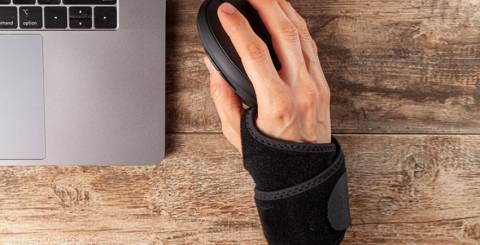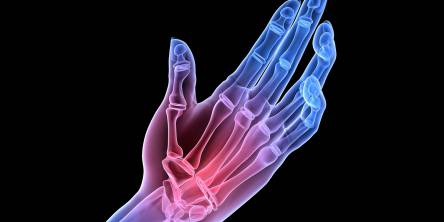6 Home Remedies to Fight Carpal Tunnel Syndrome

The carpal tunnel is a tiny corridor over the bones and ligaments on the palm side of your wrist. Carpal tunnel syndrome occurs when the median nerve, which passes through this channel to the thumb and first three fingers, is constantly under pressure.
Inflammation in the wrist is frequently caused by a medical disease that produces swelling, such as diabetes, thyroid problems, or an inflammatory ailment like rheumatoid arthritis. Another cause is fluid retention during pregnancy or menopause, as well as repetitive wrist movements.
Tendons flow through a thin tunnel over the carpal, or wrist bone, in a limited area like the wrist. When stressed cells produce lactic acid, which can bind the fibers together for protection, inflammation produces swelling. As a result, carpal tunnel syndrome can cause nerve injury.
1. Conventional therapies
The most frequent carpal tunnel treatments involve either immobilizing the affected area to prevent repetitive motions or surgically opening up the area to relieve pressure. However, according to a study published in the Journal of Orthopaedic & Sports Physical Treatment, physical therapy may be just as effective as surgery. The study tracked 100 women with the illness from Madrid; half of them were treated with physical therapy and the other half with surgery.
Researchers discovered that physical treatment (specifically, manual therapy) enhanced hand and wrist function and reduced discomfort just as well as a typical operation for the ailment. Furthermore, after one month, patients who had physical therapy reported greater improvements than those who received surgery.
2. Treating with cold and vibration
You've certainly heard that cooling the inflamed area can help with carpal tunnel syndrome, but Baxter warns that this stiffens muscles and tendons and restricts blood flow. Massage the affected area after icing to increase blood flow. The massage keeps the muscle fibers pliable, which reduces re-injury damage from moving fibers seeking to cling together to prevent movement and makes ice more pleasant.
3. Rest
Resting your fingers, hand, and wrist is the most basic carpal tunnel treatment. Stop any activities that you believe are producing numbness and pain. When the symptoms improve, the activity can be progressively resumed. Patients assess their home and work environments for ergonomic difficulties that may be contributing to their symptoms. Switching to an ergonomic keyboard or mouse, adjusting the position of the keyboard and mouse to allow the wrists to be in a neutral position, or utilizing a padded wrist rest may help ease symptoms. Patients at home could stretch and exercise their hands and wrists during breaks from repetitive duties.
4. Stretches
Simple wrist exercises can be done at any time of day, whether at your desk at work or while waiting in line at the store. To treat wrist pain, the American Academy of Orthopaedic Surgeons recommends creating a fist and then sliding your fingers until they are straight again, repeating the procedure five to ten times. If you suffer from fluid retention due to pregnancy or a fracture, make it a practice to elevate your hands and wrists whenever possible.
5. Nighttime splints
Maintaining straight wrists can help ease pressure on your median nerve. Because symptoms are more common at night, using a splint at night may help ease your symptoms before they begin. You can also use wrist splints during the day if you have problems with repeated duties at work.
The splint's objective is to retain the wrist in a neutral position, keeping the tunnel open and reducing nerve pressure. People often sleep with their wrists bent, which aggravate
s the pain. These splints can also be worn while participating in an activity that aggravates the discomfort.
6. Anti-inflammatory treatmentsMild cases may benefit from anti-inflammatory medications like ibuprofen or naproxen. Other anti-inflammatory methods, such as acupuncture and natural anti-inflammatory chemicals like turmeric and omega-3, have been found to aid some individuals with mild instances. However, if addressed, persistent or worsening symptoms such as continual burning or tingling, the advent of persistent numbness, or the onset of weakening might become permanent.
Similar Articles
Whether you're having trouble moving body parts or experiencing worsening joint discomfort, an orthopedic doctor can help. They can treat anything from a minor strain to complex treatments such as shoulder replacement. The appropriate treatment from an orthopedic expert at the right time might relieve your pain and improve your symptoms in less time.
When it comes to trauma, professionals in the mental health sector readily admit that no single style of therapy or intervention is appropriate for every case or individual.
Rheumatoid arthritis (RA) is a type of autoimmune disease that occurs when the body's immune system attacks the lining of joints, causing inflammation and causing symptoms like pain and stiffness. RA usually affects both sides of the body in a similar way, but small joints of the hands and feet are often affected first, often knuckle joints of the fingers.
An electroencephalogram (EEG) is a test that measures the electrical activity in the brain. Healthcare experts utilize it to evaluate and comprehend neurological illnesses, sleep disorders, and brain damage.
So, your back decided to stage a mutiny and gift you with a herniated disc. Lovely. Now what? If you’re imagining a future filled with endless discomfort and groaning every time you get out of bed, don’t fret. There are plenty of ways to tackle a herniated disc and get back to living your best, pain-free life.
Back pain – it’s not just a matter of “I lifted a heavy box, and now my back hurts.” It’s often the result of a complex dance between our minds and bodies, with stress, anxiety, and emotions playing lead roles. If you’ve ever woken up with a stiff back after a tough week or felt your spine twinge just from reading a long email chain, you’re not alone.
Chronic pain is a medical problem that affects many people around the world. Unlike acute pain, which is a short-term response of the body to tissue damage, chronic pain lasts longer, often without obvious physical damage. It can last from several months to several years, and its consequences can affect all aspects of a person's life
When was the last time you gave your veins some love? These hardworking highways of blood don’t ask for much—just a little support and, occasionally, professional attention when they’re not performing at their peak.
These small plastic containers are a household staple, but disposing of them incorrectly only adds to the growing waste issue. Learning to eco-dispose pill bottles reduces your footprint and shows love and respect to the planet and future generations.









